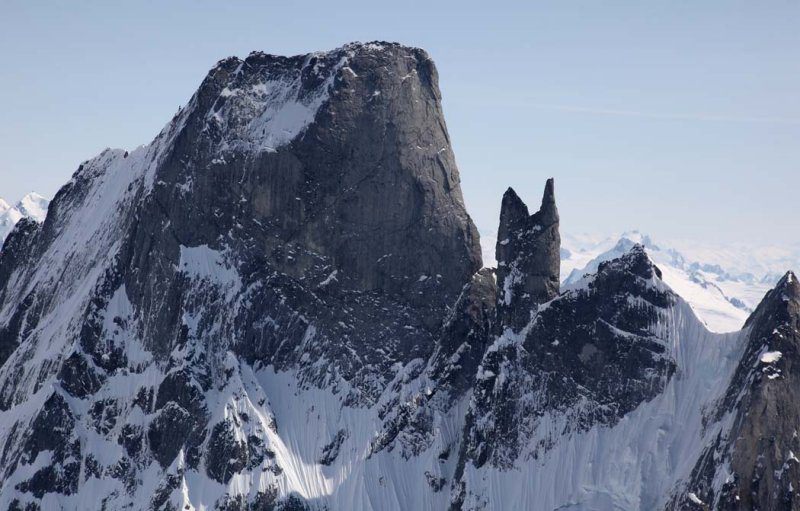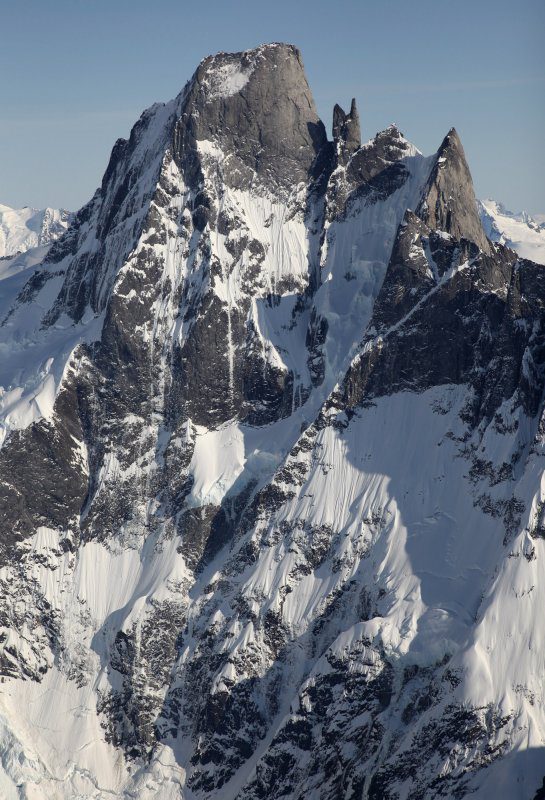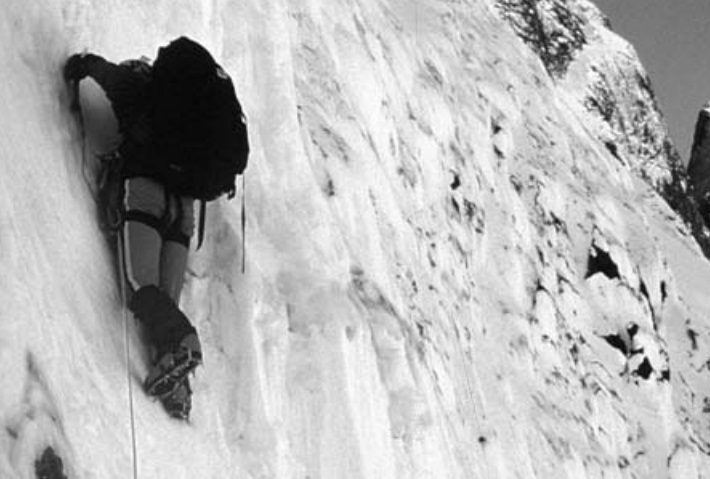Big Devil’s Thumb Face Remains Dangerous Challenge
It's one of the most dangerous walls in North America

Since 1977, 13 expeditions have travelled into the shadow of the Devil’s Thumb to attempt the coveted first ascent of the steep Northwest Face. Guy Edwards and John Millar, both experienced climbers from Vancouver, disappeared on the 2,000-metre face in mid-April 2003, during a week of unsettled weather and frequent avalanches.
Officials called off the search after repeated helicopter forays revealed no trace of the missing pair. Edwards, one of Canada’s best all-round climbers who pushed limits, was remembered by climbing partner Sean Isaac here.
Many climbers who travel to make an attempt never start up the wall because of bad condition, including ace alpinist Alex Lowe. Some have made it up a few hundred metres and some moved onto the ridges. Below is a timeline of attempts on the massive alpine face.
August 1977: Peter Cole, Nichols Rouner and Rainsford Rouner attempted the wall with almost no snow. Rouner was killed from rockfall.
August 1977: Bob Plumb and Dave Stutzman attempted the wall and ended up doing the North Pillar, a 60-pitch hammer-less and bold climb.
April 30 to June 3, 1981: Mike Bearzi and Bob Rugo arrived to the wall in good condition, but it rained for three weeks.
April 17 to May 23, 1982: Mike Bearzi and Dieter Klose approached from sea level, as did Steve Monks and Damian Carroll. Both teams waited out storms. Bearzi made one wild lead up high on the face. Everyone bailed safely.
April to May, 1983: Mike Bearzi and Art Wiggins arrived but had no good conditions to make an attempt.
April to May, 1994: Mike Bearzi and Barry Rugo climbed a short ways up and turned around due to weather. Rugo said, “My feeling is that someone will, through a combination of luck and manic resolve, get up the thing. They’ll be moving light, non-stop, and not placing much gear because there won’t be much to place. The upper headwall should nonetheless stimulate some ass-clenching pauses.”
May 5 to May 18, 1995: Bill Belcourt and Randy Rackliff found the wall avalanching and made the first ascent of the West Witches’ Tit.
April 20 to April 30, 1997: Alex Lowe and Randy Rackliff approached in poor conditions and didn’t attempt the wall.
April 18 to May 3, 1998: Bruce Miller and Jack Roberts attempted but bailed quickled. Miller said, “The face is conditionally challenged. Avy right down the middle as soon as the sun hits. A trip I’m trying to forget.”
March 18 to April 5, 1999: Conny Amelunxen, Sean Easton, Keith Reid waited but a storm never really passed. Easton said, “An immense wall, requiring just the right combination of weather conditions to set up a face that spans a huge range of temperatures and climbing mediums. Someday a lucky party will be sitting at the base and hit the jackpot.”
April 24 to June 3, 1999: Lionel Daudet and Sebastian Foissac found the face out of condition so made the third ascent of Burkett Needle using a portablede over 24 days.
May 16 to June 5, 2002: Guy Edwards and John Millar found poor conditions and didn’t attempt the wall. Instead they climbed new routes on West Witches’ Tit and Cat’s Ears Spire for the second and third ascents. Edwards said, “One of the largest prizes that I know of. We watched the face…with lots of objective hazard. The face starts at such a low altitude—you certainly need cold weather to Sammy Serac cuts loose a lethal sweep. This and many other avalanche clouds engulf base camp 1.5 miles climb the lower part safely. The face is so big there’s always a lot of threatening snow, ice, and rock above you. The Devil’s own face.”
No team to attempt the big face lacked experience or skill, but conditions have always been the factor.
“It is a dangerous and difficult face that rarely, if ever, comes into condition,” says Dieter Klose, who in 1982 made it halfway up the route, higher than anybody else alive.
As Klose says, “It’s a sanctuary where only the birds may alight, and then only so long as the avalanches deign.”

Klose wrote about his attempt from the early 1980s in The Fickle Face and said:
“Several factors lend to the difficulty of finding the face in condition. As a rock climb it’s a perfect place to commit suicide, for reasons I’ll discuss later. “In condition” means fully iced-up, move-fast terrain. This appears to be possible only during the spring transition, when just the right amount of storms and thaw-freeze conditions coat the face in white and a touch of blue.
“For a justified attempt, these conditions must then be followed by a promise of at least two days of clear skies in order to quickly climb through the 4,000-plus vertical feet of avalanche-prone zones. Sadly, this springtime period is usually one of unsettled weather, where an apparent clearing is usually just a brief tease. Making a bad call on the weather at this point could leave one stranded up high for weeks, if not avalanched off the wall entirely.
“The crux of the diretissima, the steep band at half-height, is concave; any precipitation causes lethal avalanches here, which continue onto the lower face (which is also threatened by a hanging glacier). The steep band is generally the last portion to properly ice-up. Due to the rather atrocious weather in the region, the face has been seen to ice-up splendidly, only to be melted off by a following period of rain, described by Guy Edwards as John Millar on a rest break during the 2002 approach to the Devil’s Thumb.
“Lastly, as Alex Lowe put it, scoffing, the face is simply “too low.” Starting at an elevation of a mere 2,500 feet and ending at the 9,077-foot summit, the route is indeed low by alpine standards, even taking into account a latitude of 57 degrees north. After icing-up, the lower wall tends to fall apart in short order while the upper portion still beckons. Or, vice-versa. When I was on it, the lower half was in perfect nick, whereas the upper half was out. Perhaps it had fallen apart and needed to get itself back together. Quite the neurotic little über-wall.”
The Northwest Face of Devil’s Thumb remains a big challenge for today’s alpine climbers. Maybe it will ever be climbing, maybe it’s unclimbable, but there’s no doubt another team of keen climbers will attempt it.



